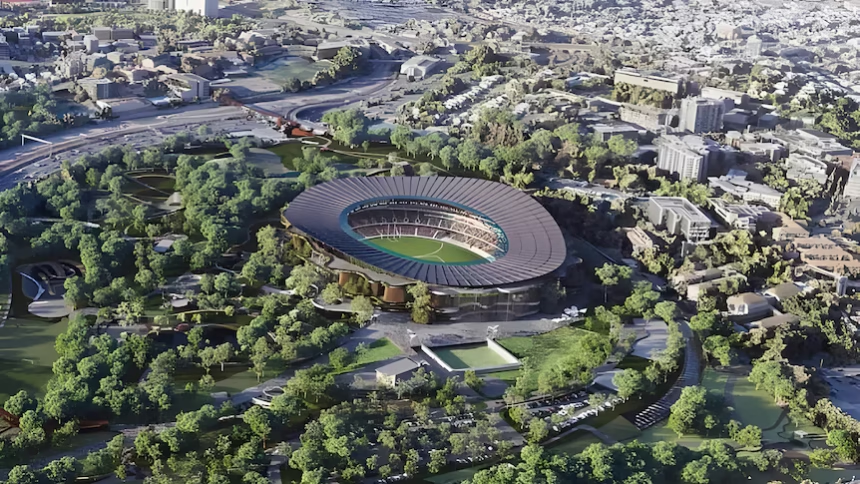The Queensland government has unveiled an ambitious infrastructure plan for the 2032 Brisbane Olympic and Paralympic Games, featuring the construction of a new 63,000-seat stadium in Victoria Park. This state-of-the-art facility will serve as the centerpiece for the Games, hosting the opening and closing ceremonies as well as athletics events. Post-Games, the stadium is slated to become Brisbane’s premier cricket venue, succeeding the historic Gabba stadium, which will be demolished to make way for housing developments.
Revised Infrastructure Strategy
This announcement marks a significant shift from earlier plans. Initially, the government proposed a $1.5 billion upgrade to the Queensland Sport and Athletics Centre (QSAC). However, following a comprehensive 100-day infrastructure review, the decision was made to invest $3.8 billion in constructing the new Victoria Park stadium. This move aligns with the government’s commitment to delivering a “uniquely Queensland” Games that balances global standards with local character.
Beyond the main stadium, the infrastructure plan includes:
National Aquatic Centre: A new 25,000-seat facility to be built in Spring Hill, near the main stadium, dedicated to swimming and other aquatic events.
Brisbane Arena: Originally proposed for the Brisbane Live precinct, the arena’s location has been shifted to the vacant GoPrint site in Woolloongabba, with funding expected from the private sector.
Arena: An upgraded 20,000-seat arena at the Brisbane Showgrounds, enhancing the city’s capacity to host large-scale events.
Athletes’ Villages: The establishment of three hubs located on the Gold Coast, Sunshine Coast, and Brisbane’s RNA Showgrounds to accommodate athletes during the Games.
Regional Engagement and Legacy
In a move to spread the benefits of the Games across the state, several events will be hosted in regional areas. Notably, rowing competitions are planned for the Fitzroy River in Rockhampton, a location known for its resident saltwater crocodiles. Premier David Crisafulli addressed safety concerns with characteristic humor, stating, “If it’s good enough for central Queensland kids, I reckon it’s good enough for Pierre from Paris.”
Community and Environmental Considerations
The selection of Victoria Park for the new stadium has sparked local opposition, particularly from groups advocating for the preservation of green spaces. The government has assured that the development will prioritize environmental sustainability and community access, aiming to balance urban development with ecological preservation.
Funding and Budget
The revised infrastructure plan is projected to remain within the original $7.1 billion budget allocated for the Games. The government anticipates significant private sector investment, especially in projects like the Brisbane Arena, to reduce the financial burden on taxpayers. Contributions from organizations such as Queensland Cricket and the AFL are also expected to support venue costs.
Government’s Commitment
Premier Crisafulli acknowledged the departure from previous commitments not to build new stadiums but emphasized the necessity of these developments for the state’s future. “I have to own that, and I will. I am sorry—it’s my decision, and I accept that,” he stated, highlighting the importance of delivering infrastructure that meets both the immediate needs of the Games and the long-term interests of Queenslanders.
Architectural and Urban Planning Perspectives
The Australian Institute of Architects has urged the government to consider the impact of Olympic venues on everyday life and the city’s architectural heritage. They emphasize the importance of integrating new developments seamlessly into Brisbane’s urban fabric, ensuring that the city’s character and heritage are preserved.
Economic and Social Impact
Hosting the 2032 Games is expected to provide significant economic benefits, including an estimated $4.6 billion boost in tourism and trade for Queensland and $8.5 billion nationally. The infrastructure developments aim to leave a lasting legacy, enhancing the city’s global profile and providing state-of-the-art facilities for future generations.
Public Consultation and Feedback
The government has initiated a public consultation process, inviting residents to provide input on the infrastructure and planning for the Games. This approach aims to ensure that the developments align with community needs and aspirations, fostering a sense of ownership and pride among Queenslanders.
This comprehensive plan reflects Queensland’s dedication to hosting an Olympic and Paralympic Games that not only showcases athletic excellence but also delivers lasting benefits to the community and the state’s infrastructure.









